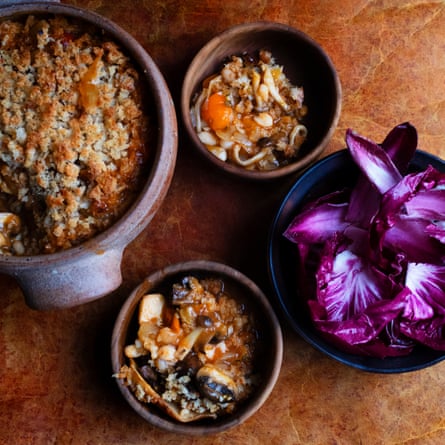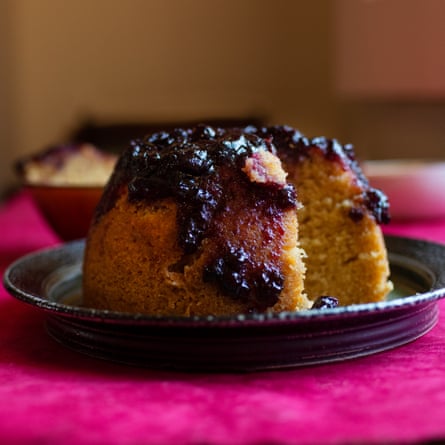
The days are cold, the nights even more so. Time to share food that will bolster us against the weather; good things to eat that will light up the dark days of deepest winter, bringing cheer and conviviality. Casseroles with crusts of crisp crumbs in which to push your serving spoon oh-so deeply; meat slowly cooked on the bone with a hearty, richly aromatic sauce; a potato supper with melted cheese and curls of crisp, smoked bacon. Oh, and pudding, there must be pudding, brought steaming to the table with a crown of homemade jam and a jug of custard. These are the dishes I want to see on the table throughout the winter.
Cooking is a marvellous way of getting through the dark months. Yes, there is the pleasure of eating our handiwork but, even more so, the chance to spend a good part of our day in the warmth of the kitchen, peeling and chopping vegetables, simmering stock, perhaps tending to a steamed pudding.
Big-hearted recipes that send waves of thyme, garlic and sweet steam through the house. The wait for dinner might seem endless, but the anticipation is half the point of winter cooking, and a good reason why we should sometimes take the slow road to supper.
Slow roast belly pork with butter beans and balsamic vinegar (pictured above)
A big dish this, with thick, jagged slices of pork on the bone, a pile of steaming butter beans at their side. Save this for those who positively relish sucking and gnawing at rib bones and chewing at crackling.
Serves 4
pork belly 1.9kg, bones in, skin scored
onions 2 medium
carrots 2 medium
celery 2 stalks
olive oil 3 tbsp
rosemary 6 sprigs
garlic 3 cloves
tomatoes 375g
vegetable stock 500ml
butter beans 1 x 700g jar or 2 x 400g tins
balsamic vinegar 1 tbsp
Take the pork out of the fridge and leave it uncovered in a cool place for an hour or so.
Heat the oven to 220C fan/gas mark 9. Rub the pork with salt and place it skin side up in a roasting tin. Roast for 25 minutes or so till the skin is a little puffed and starting to crackle, then lower the heat to 160C fan/gas mark 4 and cook for about 1½ hours.
Meanwhile, peel and roughly chop the onions. Trim the carrots, cut them in half lengthways, then into short pieces of about 1cm. Cut the celery into pieces of a similar size.
Warm the oil in a medium to large saucepan over a moderate heat, add the onion, carrots and celery, and leave to cook for about 15 minutes, stirring regularly, until the vegetables are starting to soften. While they cook, pull the leaves from the rosemary sprigs and chop them finely. Peel the garlic, slice very thinly then stir, with the rosemary, into the softening vegetables and continue cooking.
Roughly chop the tomatoes, then add them to the pan, stirring the mixture well. Once the tomatoes have softened and collapsed – a matter of 5-10 minutes – pour in the stock and bring to the boil. Season with salt and black pepper and turn down the heat, leaving everything to simmer for 10 minutes.
Drain the beans and stir into the vegetable mixture together with the balsamic vinegar, then set aside.
When the pork has been cooking for 1 hour, remove briefly from the oven and transfer the beans around the meat, taking care not to get any on the crackling. Continue roasting for 30 minutes or until the meat is tender.
Mushroom ‘cassoulet’
You can use any mixture of mushrooms here, or you could even stick to one variety, but the contrast between fragile shimeji and the more beefy texture of field and shitake mushrooms is pleasing. A few dried porcini will bump up the umami notes even further. Don’t skip the crust – it makes the whole thing especially satisfying on a winter’s night.
Serves 4-6
onions 2
olive oil
garlic 3 cloves
tomatoes 250g
bay leaves 3
thyme 4 sprigs
rosemary 3 sprigs
tomato puree 1 tbsp
dry marsala 50ml
vegetable stock 250ml
haricot beans 2 x 400g tins
For the mushrooms
king oyster mushrooms 200g
brown chestnut mushrooms 150g
shitake 125g
small, fragile mushrooms such as shimeji or small buttons 80g
For the crust
white breadcrumbs 125g
thyme leaves 1 tbsp
olive oil a little
Peel and roughly chop the onions. Warm 3 tablespoons of oil in a deep pan over a moderate to high heat, then cook the onions till they are starting to soften – about 10-15 minutes. Peel and thinly slice the garlic and stir into the onions.
Roughly chop the tomatoes and stir them into the onions together with the bay leaves. Chop the thyme and rosemary leaves, mix them into the onions and let everything cook over a low to moderate heat for 10 minutes till all is soft and fragrant.
While the onions are softening, prepare the mushrooms. Cut the king oyster into thick slices – about the thickness of a pound coin – and quarter the chestnut mushrooms. Cut each shitake in half. Trim the roots from the shimeji. Pour 4 tablespoons of olive oil into a shallow pan over a moderate to high heat, then cook the mushrooms in small batches for a few minutes until they have started to colour a little. Set aside.
Stir the tomato puree into the pan with the tomatoes and onions and continue cooking for 5 minutes, then add the marsala and stock. Bring to the boil, then immediately lower the heat. Drain the beans and stir them in, then simmer for 5 minutes.
Heat the oven to 180C fan/gas mark 6. Stir the mushrooms into the onions and beans and transfer to a deep, ovenproof casserole.
Season the breadcrumbs with salt and black pepper, and the thyme leaves. Spoon the breadcrumb mixture over the surface of the casserole then trickle over a little olive oil – just enough to lightly moisten the crumbs.
Bake in the preheated oven for about 35-40 minutes until the casserole is bubbling around the edges and the breadcrumbs are crisp and golden.
Smoked bacon with cheddar and onion mash

A good recipe for using up leftover mash, but also one which I am happy to work through from scratch. You really don’t need to peel the potatoes – this dish has a rustic feel to it, and I prefer to leave the skin on. Use whichever bacon you like, but I like a mixture of fat-marbled streaky and the leaner back. Smoked rashers seem particularly fitting for the season.
Serves 2, generously
potatoes 1kg
onion 1
olive oil 2 tbsp
thyme leaves 2 tsp
smoked back bacon 4 rashers
smoked streaky bacon 4 rashers
cheddar 85g, grated
Put a pan of water on to boil, either with a steamer attachment or colander that will sit in the top without touching the water. Scrub the potatoes. Cut them into large pieces and put into the steamer basket and cover with a lid. Let the potatoes cook for about 20 minutes or until tender.
Peel the onion, slice it in half, then cut each half into about 4 or 5 segments. In a shallow pan, warm the oil over a moderate heat, add the onion, stir in the thyme leaves and leave to cook, with the occasional stir, until golden and translucent. Set aside.
Grill the bacon till lightly crisp – only you know how you like your bacon cooked.
Mash the potatoes coarsely with a fork, then stir in the grated cheese and cooked onion. Serve aside the grilled bacon.
Roast parsnips with honey and ricotta

Glistening with honey, ricotta and thyme, roast parsnips are something to serve with slices of cold roast meat or, as I did the other day, with baked flat mushrooms with tarragon and lemon butter. You can roast them without the initial steaming, but that can result in tougher, chewy parsnips. Better, I think, to steam them first, which results in a fluffy interior.
Enough for 4 as side dish
parsnips 900g
butter 30g
olive or vegetable oil 3 tbsp
runny honey 3 tbsp
thyme leaves 1 tbsp
ricotta 100g
Get a pan of water on to boil and have a steamer basket or colander to hand. Peel the parsnips, cut them in half and then into short lengths, rather like the size you do for roast potatoes.
Lower the parsnips into the steamer basket, place it over the boiling water and cover tightly with a lid. Adjust the heat as necessary to keep the water boiling without boiling over, and let the vegetables steam for 20 minutes till approaching tenderness.
Set the oven at 210C fan/gas mark 8. Melt the butter and olive oil in a roasting tin in the oven, then add the steamed parsnips. Toss them in the oil so they are glistening, then roast for about 35-50 minutes till they are golden and lightly crisp.
Season the parsnips with salt and black pepper, trickle the honey over them, then return to the oven for a further 7 minutes.
Mix the thyme and ricotta together. Place spoonfuls of the cold ricotta on the hot, sizzling parsnips and serve immediately.
Blackcurrant jam sponge pudding

In the depths of winter, I want to bring to the table a pudding to share, a veritable dome of sponge, sweetly spiced, a crown of jam dripping down its sides. Here it is.
Serves 6
butter 150g
caster sugar 150g
eggs 2 large
self-raising flour 150g
ground cinnamon 1 level tsp
ground ginger 1 level tsp
lemon finely grated zest of 1
milk 2 tbsp
blackcurrant, plum or apricot jam 4 heaped tbsp
Prepare the pudding basin. Cut a disc of greaseproof paper or baking parchment to fit the base of a 1.5-litre pudding basin. Rub a little butter around the inside of the basin.
Cream the butter and sugar together till pale and fluffy. An electric mixer will do this in minutes. Break the eggs into a small bowl and beat lightly with a fork to mix white and yolks together. Add the eggs, a little at a time, to the butter and sugar, mixing well between each addition. If there is any sign of curdling – and there often is – introduce a spoonful of the flour.
Put a large, deep pan of water on to boil, enough to come halfway up the sides of the basin. Sieve together the flour and spices, then mix into the butter and sugar with the lemon zest. Stir in the milk. Spoon the jam into the base of the pudding basin, then transfer the pudding mixture into the basin, smoothing the surface gently.
Cover the basin with greaseproof paper and foil, tightly secured, or a clip-on lid, and place into the pan. Cover the pan with a lid and cook the pudding at a spirited simmer for 1½ hours. Check the water level from time to time and top up if necessary
Leave the pudding in the water for 15 minutes to let it settle. Remove the foil and paper, or the lid, then turn out on to a plate. Offer a jug of cream or custard at the table.



